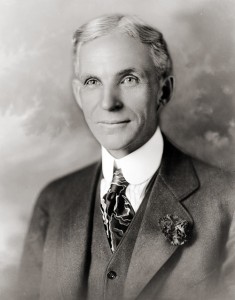Howard Hughes was a complex man. He was a pioneer aviator, engineer, industrialist, film producer and a playboy. He became one of the world’s wealthiest men, a billionaire.
Hughes first 2 films, Everybody’s Acting and Two Arabian Knights, were financial successes in 1927. Two Arabian Knights won Academy Awards for Best Director of a Comedy Picture in 1929. Other Hughes films nominated for Academy awards were, The Racket in 1928 and The Front Page in 1931. One of the first big budget films, Hell’s Angels, cost $3.8 million. Hughes not only wrote and directed the movie, but he financed the movie himself. In 1932, Hughes also produced Scarface, which was loosely based on the life of Al Capone. The 1941 film, Outlaw, made a star of Jane Russell but caused the industry censors concern due to the special bra that Hughes, the engineer designed for the revealing costume Jane Russell wore.
Hughes the playboy, spent much of his time in Hollywood with many famous women such as Katharine Hepburn, Olivia DeHavilland, Ava Gardner, Bette Davis, Lana Turner, Gene Tierney and Joan Fontaine, whom he proposed to on two separate occasions.
Hughes father, Howard Robard Hughes Sr, found of the Hughes Tool Company. His wealth came from inventing the ‘rock eater’, a drill bit that revolutionized oil drilling .Hughes Aircraft Company was founded in 1932 by Hughes as a division of Hughes Tool Company.
Hughes designed and built several aircraft himself while heading Hughes Aircraft and the most technologically important aircraft was the Hughes H-1 Racer., Hughes, flying the H-1, set the airspeed record of 352 mph in September 1935. The H-1 Racer featured a number of design innovations including retractable landing gear and all rivets and joints set flush into the body of the plane, to reduce drag. The H-1 Racer was donated to the Smithsonian in 1975 and is on display at the National Air and Space Museum. On July 10, 1938 Hughes set another record by completing a flight around the world in just 91 hours.
Due to his aviator feats, he received numerous awards, including the Harmon Trophy in 1936 and 1938, the Collier Trophy in 1939, the Octave Chanute Award in 1940, and a special Congressional Gold Medal in 1939 – ..in recognition of the achievements of Howard Hughes in advancing the science of aviation and thus bringing great credit to his country throughout the world.
Due to an oil leak, Hughes, piloting the experimental U.S. Army spy plane XF-11 over Los Angeles was in a near-fatal aircraft accident in July 1946. The plane crashed in Beverly Hills, mowed down three houses, and the fuel tanks exploded, setting fire to the plane and a nearby home. Hughes, wounded, was rescued by Marine master sergeant William L. Durkin . Hughes major injuries included a dislodged heart, crushed collar bone, six shattered ribs and numerous third-degree burns.
Hughes most famous aircraft was the “Spruce Goose (H-4 Hercules). The plane was originally commissioned by the U.S. government for use in World War II, as a viable way to transport troops and equipment across the Atlantic out of range of German U-Boats. It was a massive flying boat weighing 190 tons but was completed just after the end of WW II. The Hercules flew only once for a mile (with Hughes at the controls) on November 2, 1947. The plane was on display in Long Beach, California next to the Queen Mary for many years, but is now part of the Evergreen Aviation Museum.
Hughes took control of TWA In 1939, after purchasing nearly $7million of TWA stock. Under federal law Hughes was not allowed to build his own airplanes. Since Hughes already had a good relationship with Lockheed (they had built the plane he used in his record flight around the world in 1938), and asked them to replace TWA’s fleet of Boeing planes. The revolutionary Constellation, was built in total secrecy. 1956, Hughes ordered 63 Convair 880s for TWA at a cost of $400 million. Although Hughes was extremely wealthy at this time, outside creditors demanded that Hughes cede control of TWA in return for providing the money. In 1960, Hughes was ultimately forced out of TWA, although he still owned 78 percent of the company and continued try to regain control.
Hughes took control of RKO studio’s in 1948. Within weeks of taking control, Hughes fired ¾ of the employees causing production to be shut down for six months. His over controlling style continually caused disruption with shooting schedules. After the settlement of the antitrust case, United States v. Paramount Pictures, Inc, Hughes was forced to sell the profitable the RKO theaters chain in 1953.By the end of 1954, at a cost of nearly $24 million, he had gained near total control of RKO. Six months later, Hughes sold the studio to the General Tire and Rubber Company for $25 million. This was the end of his 25-year involvement in motion pictures. Despite the fact that Hughes had destroyed a major Hollywood studio, his reputation as a financial wizard emerged unchanged since he reportedly made $6.5 million in personal profit from RKO.
One of the least known endeavors of Hughes was the Howard Hughes Medical Institute, one of the richest charities ever created. It’s $11 billion, making the Hughes Institute the second-largest philanthropy in the country, behind Bill Gates’ foundation. The goal of the institute is basic biomedical research including trying to understand, “genesis of life itself.
In the late 1950’s, Hughes became a recluse. He died in April 1976, at the age of 70 in an airplane crash on the way to The Methodist Hospital in Houston. His hair, beard, fingernails, and toenails had grown grossly long, and he weighed 90 pounds despite being 6’4”. The FBI had to resort to fingerprints to identify the body.
